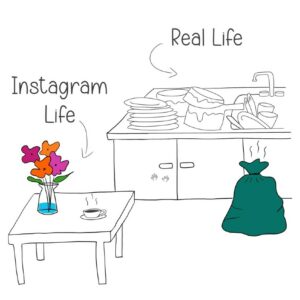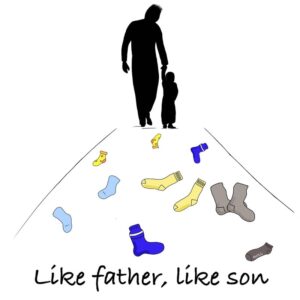Let me start by saying this: whatever goal image you’re chasing—whether it’s from Instagram, Pinterest, or some perfectly curated blog—is a LIE. Those pictures are unrealistic. That’s not how people’s homes look every day; that’s how they looked for the photo. What you don’t see is the chaos just outside the frame, the staged perfection, and the behind-the-scenes reality they’ll never show you.
We all know it, but I just wanted to remind you—just in case you needed a little reality check.

That said, here are a few tips to help keep your place looking tidy-ish
Rules for Sanity:
- Remove visual clutter.
- Install an easy-to-maintain organization system.
1. Less Stuff = Less Mess
I know, I know—it’s easier said than done. But do you really, REALLY need everything you own?
I’m no minimalist (far from it), and I definitely have too much stuff myself. So, every now and then, I edit a room, a corner, a drawer, a tray.
You don’t need to go full Marie Kondo overnight. Even decluttering one small spot makes a huge difference. We regularly go through my kid’s toys because, let’s be honest, they won’t play with the same things forever.
And guess what? The same logic applies to us adults. With our clothes but also our books, kitchen utensils, beauty products. Just go through one drawer in the bathroom today. You’ll appreciate the difference.
2. Designated Space for Toys
If you have space for a playroom (lucky you!), that’s amazing! Tell the kids: This is where the toys live, or they have to move out. (The toys, not the kids.)
My son is lucky to have a playroom, meaning his bedroom could look Instagram-worthy with the right filter, new furniture, and a fresh coat of paint.
But the playroom? Let’s say he fully embraces the chance to have a space to create chaos. There are toys, books, sticks, stones, pillows, and paints everywhere. It’s a lot, but I’m OK with it now. (It’s been a journey.)
Of course, not everyone has space for a dedicated playroom—a play corner will do just fine!
We’ve lived in much smaller spaces before—our last place had a tiny kitchen/dining room and no living area. My son’s toys were stored in a cupboard under the TV, and I defined his space with a small rug. He was even allowed to stick whatever he wanted on the window beside it. It worked.
And I can hear you thinking:
« But if they have a bedroom, can’t they just play there? »
They can. They will. Sometimes. But they want to be close to you, sometimes veeeeeery close to you.
Booh !
3. Catchall in the Entrance: First Line of Defense
The entrance is the first pain point when you walk in. Clutter here sets the (bad) mood for the whole house.
✅ A spot for keys and whatever random stuff lands there. A catchall always comes in handy
✅ Hooks for jackets, hats, and bags.
✅ A designated place for shoes. No, you do not have to buy a new piece of furniture. We had one, and it was always FULL of shoes. Now we just leave our shoes close to the entrance, hopefully neatly aligned against the wall. It’s easier to see which ones overstay their welcome and need to be removed. Like snow boots past March.
4. Closed Storage = Hidden Chaos
Let’s be real—some things are just ugly. You need a place to hide all those not-so-pretty piles of:
🗂 Papers
🔌 Cables
🧼 Cleaning products
🏃♂️💨Things lying around when unexpected guests show up
If the kids insist on playing in the living room, a designated chest to put the toys away makes cleanup quick and keeps the space looking tidy without a permanent toy explosion.
Out of sight, out of mind—but still organized! and not pushed into the next room as my sister used to do. She used to open her bedroom door, push all the mess out, close the door and was ready for the parental inspection. Funny girl.
5. Accessibility: Make Life Easy
Not everything has to be hidden away. The things you use daily should be:
- Easy to grab.
- Not blocked by stuff you only use once a month.
The fondue machine? Back of the cupboard.
The tennis rackets you use once a year? Under the bed.
Do you make waffles every morning? First, can I come over? Second, the waffle maker has earned his countertop space. Good boy.
And for the kids? Give them the chance to help.
- Low coat hooks = they can hang their stuff.
- Easily accessible bins and baskets = they can (hopefully) put things away. Dirty clothes, plush toys,
6. Make Organisation Easy to Maintain
Any system has to work for the whole family, not just you. Match your housemates’ habits instead of trying to force new ones. Note where their stuff ends up and offer a solution.
If your kids are constantly leaving their clothes in a heap on the floor, try adding a few easy-to-reach baskets or hooks where they can toss their clothes at the end of the day. This way, they’ll have a designated spot that fits their habits.
⚠️ No system will work forever—life changes, kids grow, routines shift. Be ready to adapt and tweak as needed.
Also, some people will just keep leaving their socks everywhere, and then have a son who will work on keeping the family tradition alive. I have no solution for this

Final Thoughts
Your home will never look like a showroom 24/7—and that’s OK. But with a few simple changes, you can keep it functional (and relatively sane), even with kids. Or a messy partner, roommate, or parent.
And remember: Perfection is a myth. Tidy-ish is enough.
